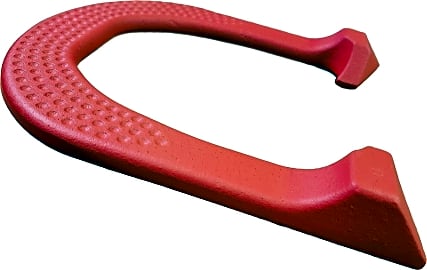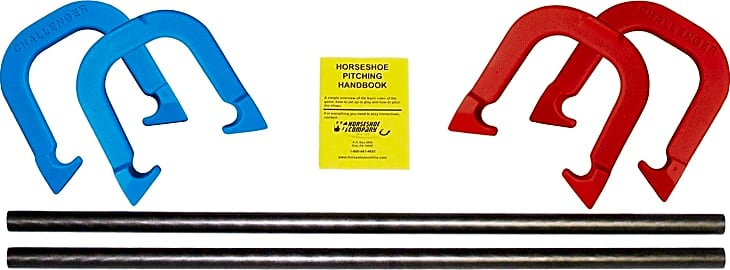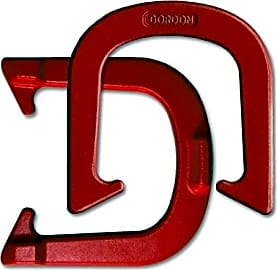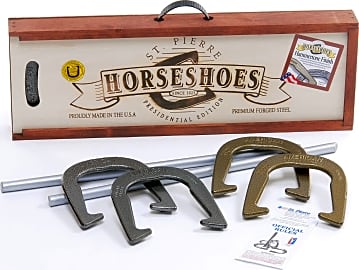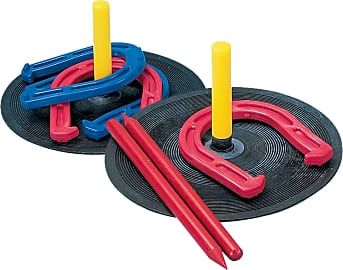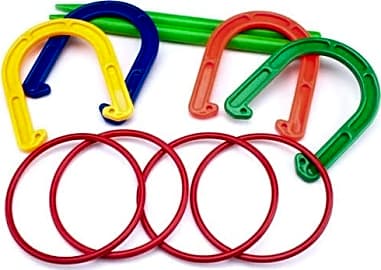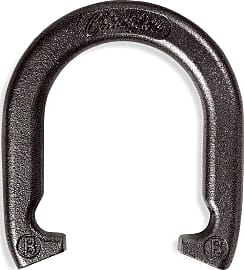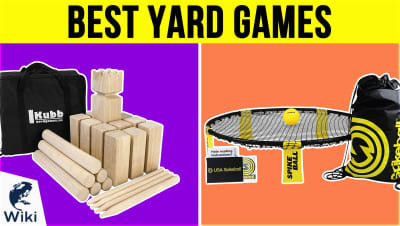The 8 Best Horseshoe Sets

This wiki has been updated 41 times since it was first published in September of 2015. Get your family and friends out from in front of their smartphones, video games, and televisions and into the fresh air for some old-fashioned fun. Quite possibly dating back to Ancient Greece, the game of quoits eventually developed into a simple and beloved pastime enjoyed by adults and children all over the world. With one of these horseshoe sets, you'll be a part of gaming history. When users buy our independently chosen editorial choices, we may earn commissions to help fund the Wiki.
Editor's Notes
July 09, 2021:
We no longer recommend the models from Baden or Viva Sol because they're hard to find in stock and basically identical to a pair of other models. Our favorites remain the Thoroughbred Flip-Grip and St. Pierre American Professional Series because of their consistent construction and official National Horseshoe Pitching Association approval. If you want a nice, matching carrying case and can afford to spend a bit more, consider the high-end St. Pierre Presidential Edition. For the most part, our recommendations here have not changed since our last update.
March 31, 2020:
To accommodate all types of players, we've kept a range of full sets as well as pairs of horseshoes with no accessories. For those who'd like the former, we still think the St. Pierre American Professional Series comes out on top. It has everything you need, including rules, and all of the components are made to last. And, given the quality, it's offered at an appropriate price. For something less expensive, there's the Champion Sports Official, but note that its pieces can't take as much abuse as can the pieces in the former set. We've also kept the Viva Sol Premium. Unfortunately, its green and blue shoes are quite similar in color, which can be frustrating, but this is a small drawback to an otherwise well-made selection.
For those who take their horseshoes seriously, and aren't looking for a yard game kit, we've added the Gordon Professional and the Thoroughbred Flip-Grip. These are weight-matched sets, each boasting quality materials and a top-notch finish. It probably goes without saying, but these, like other metal choices, can be dangerous when thrown without caution — so keep young children away from them and supervise older ones. Or, perhaps, consider the K-Roo Sports 2-in-1, which was created to be safe for kids aged 3 and older.
Special Honors
M&M Horseshoe Company Python For those who take the game seriously, the M&M Horseshoe Company Python is a reliable, well-balanced shoe. It's offered in three weights and several colors, including pink and purple, but no matter the configuration you choose, your pair will be matched to within .2 of an ounce. pitchinghorseshoes.com
A Brief History Of Horseshoes
After all, there aren't many other games you can play while holding a beer in one hand.
The first iron shoes designed to protect horses' hooves likely originated in Rome sometime around 400 B.C.E. This footwear helped keep the hoof from splitting, allowing horses to traverse long distances in inclement weather.
More importantly, though, it was quickly discovered that these shoes could be used for gambling.
At the time, the Olympic Games were quite popular, with the discus being one of the most celebrated events. Unfortunately, the equipment was too expensive for the common folk, and so they had to make do with the next best thing: horseshoes. These they had in abundance, and they would compete to see who could throw them the farthest.
Eventually, someone had the bright idea to hammer a stake into the ground and challenge others to try to hit it. This was no easy feat, as these early horseshoes weighed as much as four pounds apiece. This game was much more egalitarian, and as a result was hugely popular in Roman army camps.
As the Romans conquered their way across Europe, the game of horseshoes spread as well, eventually reaching the shores of England. The English became so fanatical about the game that two separate kings, Richard II and Edward III, banned it, hoping to inspire the citizenry to take up archery instead.
Still, the game remained popular, especially in pubs and taverns.
A set of official rules were developed in 1869, with English players standardizing the length the pitcher had to stand from the stake, the weight of the shoes, and more. This led to the rise of competitive tournaments, with the inaugural world championship being held at a horse show in Bronson, Kansas, in 1910. The winner, a gentleman named Frank Jackson, was awarded a championship belt with horseshoes attached to it.
The game was an instant hit with the crowd, although some of that may be attributed to the buzz of being in Bronson, Kansas. Nevertheless, the state would continue to be a hotbed for competition, with the game's first governing body being established in Kansas City.
This body began to slowly amend and revise the rules, changing the distance from the stake to 40 feet in 1919 and its height to 15 inches a few years later. Meanwhile, a separate governing body cropped up in Ohio in the early 1920s, but the two competing regulatory committees were able to put aside their differences and join together that same decade.
Today, it's believed that more than 10 million hobbyists play the game each year, and the National Horseshoe Pitchers Association boasts over 15,000 members. The sport is easy to learn, inexpensive to play, and surprisingly fun, so those numbers should be expected to grow in the years to come.
After all, there aren't many other games you can play while holding a beer in one hand.
Picking The Right Horseshoe Set
If you want to pick up the game, you'll need your own set. Luckily, horseshoe kits are small and easily portable, so you can ensure a fun time at the next picnic without the equipment taking up a whole room in your house in the meantime.
If you hope to use this set for years to come, it's worth springing for a premium case.
Before purchasing your set, you should have an idea of who will be playing. Kids sometimes struggle with the heavier steel shoes, and they might prefer a rubber set to get started. However, older players will appreciate the heft and feel of traditional steel pieces. Also, rubber shoes are much less painful if they hit someone, so that's something to keep in mind if your party will include a lot of children, drunks, or drunk children.
The quality of the carrying case is also worth considering. If you hope to use this set for years to come, it's worth springing for a premium case. This will help you keep the pieces organized, and reduce the chances that you'll lose anything. Of course, you can cut costs by going with a flimsier case, and lower-quality may be a good idea if you plan on taking it to the beach.
Of course, if you're really getting into the game, you'll want to make sure that whatever set you buy is approved by the National Horseshoe Pitchers Association. If you plan on participating in events, it's important that you practice with the same equipment that you'll use at competitions.
Regardless of which set you get, you'll still be able to have a good time. Don't forget — the most important thing is that you're familiar with it, because every little advantage helps when hustling Grandma at the family reunion.
Taking Your Game To The Next Level
Pitching horseshoes looks simple enough. All you have to do is get it as close to the pin as possible. Piece of cake, right?
If you've ever actually played the game, then you realize it's a little more difficult than that. However, there are some strategies and techniques that you can use to ensure that you dominate your backyard games.
If you've ever actually played the game, then you realize it's a little more difficult than that.
One of the most important things to realize is that where you hold the shoe matters. Most pros suggest holding it at the curve or at the top, but it's up to you which position feels more comfortable. Holding it at the curve is likely to give you the most control, though.
When you're ready to throw it, step into the toss with your opposite leg. So, if you're right-handed, take a step forward with your left leg to generate some momentum behind the swing. Your wrist should be facing you at the start of the toss, but facing upwards during the follow-through.
Try not to flick your wrist, either. There's no room in horseshoes for that kind of fancy play. Ultimately, you should be able to have enough power and accuracy with a straight wrist that flicking it only complicates the motion.
Beyond that, the most important thing is to practice. This is a game that's all about muscle memory, so the more familiar you are with your equipment and the proper motion, the better you'll do.
Who knows? With enough time and effort, you might crack the pro ranks someday — and then every schoolchild will memorize your name alongside the greats, like Alan Francis and...the other guy.


